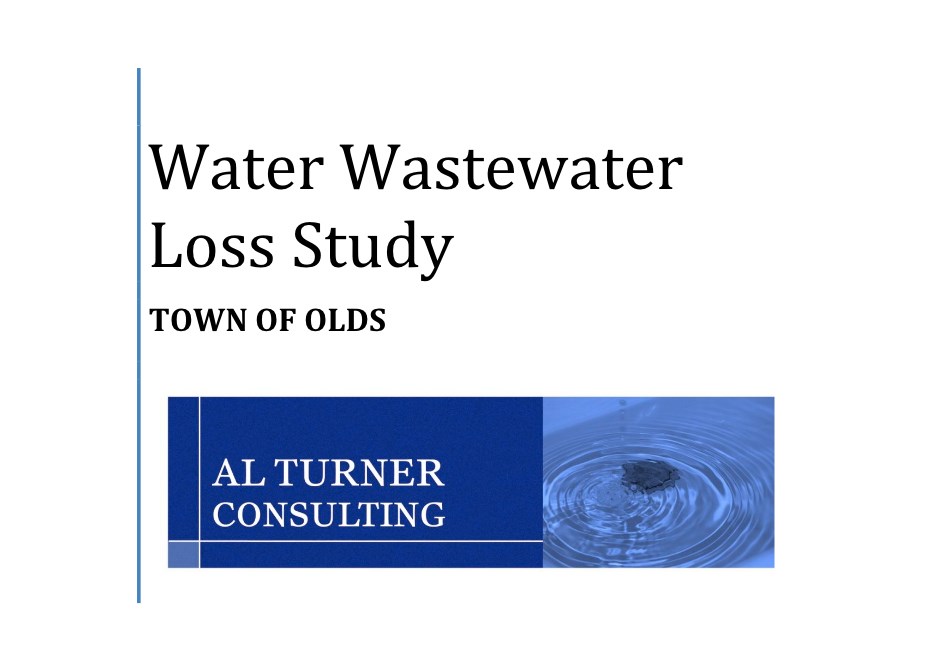A study to address long-standing problems with water loss says discrepancies between water bought by the town and the amount being billed to residents and businesses for what is used costs the town some $400,000 each year.
A study to address long-standing problems with water loss says discrepancies between water bought by the town and the amount being billed to residents and businesses for what is used costs the town some $400,000 each year.
Turner Consulting was contracted last year to investigate the problem, which dates back to at least 2006. The town historically suffers water loss upwards of 30 per cent, while industry standards tolerate an 11 to 15 per cent difference.
"You will spend more money looking for that 10 per cent than what it's worth," said Olds' chief operating officer Scott Chant.
The town purchases water from the Mountain View Regional Water Services Commission (MVRWSC), which is metered both when it leaves the Anthony Henday Water Treatment Plant near Innisfail, and when it arrives at pump stations serving the community.
Chant said that those numbers are comparable, indicating that the problem lies with the water distribution or metering within the municipality. The discrepancy between how much water the town bought and how much it billed for went as high as 44 per cent last October, according to the report.
The question is why.
"Is it actually leaving our system or is it just not being recorded properly?" said Chant.
According to the report, there are a number of possibilities to explain water distribution losses: leaks, inaccurate meters, illegal connections and theft. In addition, the town could be paying extra for wastewater, which is shipped out to the South Red Deer Regional Wastewater Commission, also at a cost.
Wastewater discrepancies come from excessive infiltration, which is groundwater entering the sewer system, and from inflow, which is other water entering the system from other inappropriate sources like residential sump pumps feeding into the waste stream.
"The wastewater was not as big an issue when we had our own wastewater treatment plant," said Chant. "We have to pay for every cubic metre that we send to Red Deer. So now it's a double whammy."
"If we are paying for, basically, groundwater or rainwater to be shipped to Red Deer, then it's a costly venture."
Field testing in the three-phase study started last June with examining water lines throughout the town for leaks. It concluded in October, with an inspection of the town's 500 sanitary and land drainage manholes.
During the leak-detection phase last June, water losses decreased to 21 per cent in August, down from 37 per cent in May and 30 per cent in June and July, as leaks were reported and repaired. The report recommended that the town appoint a dedicated employee responsible for leak detection.
The report further recommended that the town consider a yearly house-by-house inspection to search for leaks as well as meter tampering or illegal cross connections.
The report also said that Olds College comprised a major part of the study, and noted that town staff believe "there may be a separate and unmetered water feed into the college."
According to the report, consultants had hoped to test that theory during their investigation, but lacked access to private portions of the college's water system. They were "unable to effect proper testing and come to a definitive consensus on water services to the college."
"The data from this test was insufficient to form an opinion as to the existence of a fourth service feeding water from the Olds water system," read the report.
"There is sufficient anecdotal information from staff that suggests that the existence of an unknown service is a possibility. Without access to valves on the private portion of their water system, it is very difficult to determine this as a fact."
Instead, the report suggested inserting a camera into the watermain near the college in order to verify the existence of any additional water feeds to the college.
The report was presented to council during the May 15 policies and procedures meeting and was accepted for information. Chant said that the issue will come back before council with suggestions on how to implement the study's recommendations, and any associated budget considerations.
The full study is available online at http://www.olds.ca/minutes/agendas/may1517b.pdf.
"You will spend more money looking for that 10 per cent than what it's worth." SCOTT CHANT CHIEF OPERATING OFFICER TOWN OF OLDS
